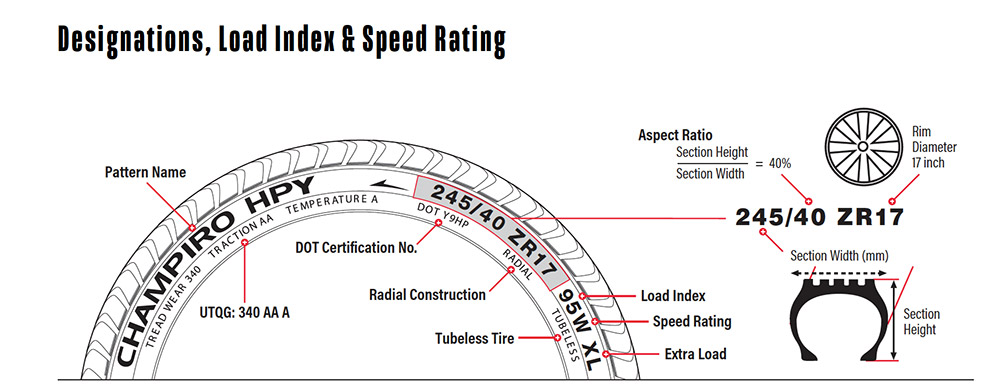What does plus sizing mean?
Plus sizing implies the increase of the rim diameter from the original fitment while maintaining approximately the same overall tire diameter, without negatively affecting the vehicle performance. Example: if a customer has a 15 inch wheel and wants to switch to a 16 inch wheel, it is known as a plus-one fitment: an 18 inch wheel would be a plus 3 fitment. To simply adopt a different tire size on an existing rim is a considered a "plus zero" fitment.
How do I read the sidewall of my tires?
image goes here
What does UTQG represent?
Uniform Tire Quality Grading. A government-mandated tire rating system based on a tire's performance in treadwear durability, traction, and temperature resistance. UTQG ratings are branded on the tire's sidewall.
What is the difference between a P- Metric and LT?
A P-Metric (per TRA standards) or Metric (per ETRTO standards) tire is designed for passenger cars, crossovers, some SUV's, and some light trucks. An LT Tire is designed and built for Light Trucks and is usually capable of a higher load carrying capacity than P-Metric or Metric sizes. Any replacement tire on any light truck must be of a size and load range that will offer equal or higher load carrying capacity compared to the original equipment tire on the vehicle. Note that size for size, LT tires require higher air pressures to carry equivalent loads of P-Metric tires. Proper air pressure is critical, insufficient air pressure will result in excessive heat build up and premature tire failure. The LT-Metric tire may provide a harsher or stiffer ride than O.E. P-metric tires.
What is the difference between a P- Metric and Metric tire?
There are two major size designations commonly used for passenger car tires, called P-metric and Metric sizing. If you see a “P” in front of the tire size displayed on a tire’s sidewall it is a P-metric tire. If there’s no P, it’s a Metric tire (also called Euro-metric or Hard-Metric). In the past, P-metrics were the most common size designation found on domestic cars, minivans, and light-duty pickups and SUVs. Foreign cars generally came with Metric tires. These days, however, you may find P-metric and Metric tires on all types. For example, look at the differences between a P215/60R16 and 215/60R16 tire, they have about the same dimensions and appear to fit interchangeably, but there is a difference in the two- or three-digit number following the size called the load index. The higher the load index, the greater the load-carrying capacity of the tire. The P215/60R16 has a load index of 94, corresponding to a maximum load of 1,477 lbs at 35 psi; the 215/60R16 tire has a load index of 95 for a maximum of 1,521 lbs at 36 psi. Both types use different load and inflation formulas; as a result, a metric tire has a slightly greater load index and higher load-carrying capacity reserve than its P-metric counterpart.
Can you use P-metric and Metric tires interchangeably when buying replacement tires?
"If your car came with P-metric tires, you can replace them with P-metric or Metric tires. The Metric tire will have greater load capacity reserve than what came on the car as original equipment and is an acceptable substitute. Since P-metric tires have a lower load capacity reserve than their Metric counterparts, you shouldn’t use a P-metric tire size counterpart of the Metric tire that came on your car as original equipment. It is also recommended not to mix P-metric and Metric tires on a vehicle as it could compromise handling, braking, and cornering performance."
Can I really go as fast as my tires speed rating says I can?
It is never recommended to exceed speed limits. It is always recommended to drive in a safe and reasonable manner. Tire speed ratings are assigned to tires based on a series of test conditions. A tire speed rating does not mean you can drive a vehicle as fast as the rating allows, anytime. Drivers often miss the fact that tire speed ratings are based on near optimal conditions-perfect temperatures, safe conditions, etc. Drivers in Texas won't get the same performance from a tire in the summer heat as a driver in Canada in the dead of winter. An increase in speed means an increase in heat as the tire rotates on the pavement. Summer heat, road debris, and other variables may also affect heat generation--don't try to approach the maximum speed rating of your tires under these conditions
Can I mix different speed - rated tires on my car?
If tires of different speed ratings are mounted on a vehicle, the lower speed rated tires should be placed on the front axle. This is to prevent a possible oversteer condition. Vehicle handling may be affected, and the vehicle's speed capacity is now limited to the lowest speed-rated tire.
Do GT Radial tires have a balance mark on them?
No there is no balance mark on GT Radial sidewalls.
How much weight/load can my tire carry?
The maximum tire load limit is molded on the sidewall of the tire. The maximum vehicle load limit is on the tire information placard located on the vehicle door edge, door jam, or glove box door.
How do I determine if my current rim is approved for your tires?
Rim range represents the allowed rim widths that will assist the tire and wheel in meeting its performance potential. By selecting a rim width in the middle of the manufacturer’s range, will achieve balance between ride, handling and tread wear. Choosing a rim nearer the maximum width allowed, improves cornering traction and steering response. Using a rim at the lower end of the range will create curve out on the tire, slowing steering response.


